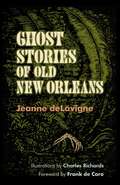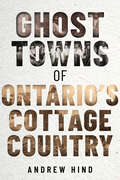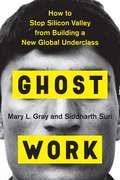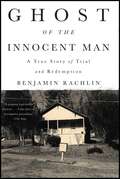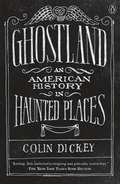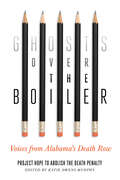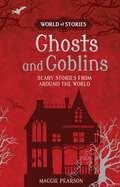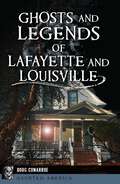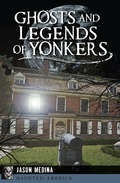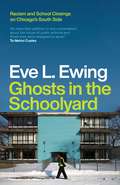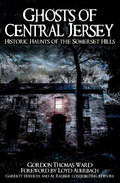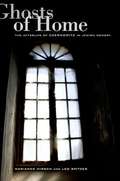- Table View
- List View
Ghost Stories of Old New Orleans
by Frank De Caro Charles Richards Jeanne DeLavigne"He struck a match to look at his watch. In the flare of the light they saw a young woman just at Pitot's elbow -- a young woman dressed all in black, with pale gold hair, and a baby sleeping on her shoulder. She glided to the edge of the bridge and stepped noiselessly off into the black waters." -- from Ghost Stories of Old New OrleansGhosts are said to wander along the rooftops above New Orleans' Royal Street, the dead allegedly sing sacred songs in St. Louis Cathedral, and the graveyard tomb of a wealthy madam reportedly glows bright red at night. Local lore about such supernatural sightings, as curated by Jeanne deLavigne in her classic Ghost Stories of Old New Orleans, finds the phantoms of bitter lovers, vengeful slaves, and menacing gypsies haunting nearly every corner of the city, from the streets of the French Quarter to Garden District mansions. Originally printed in 1944, all forty ghost stories and the macabre etchings of New Orleans artist Charles Richards appear in this new edition.Drawing largely on popular legend dating back to the 1800s, deLavigne provides vivid details of old New Orleans with a cast of spirits that represent the ethnic mélange of the city set amid period homes, historic neighborhoods, and forgotten taverns. Combining folklore, newspaper accounts, and deLavigne's own voice, these phantasmal tales range from the tragic -- brothers, lost at sea as children, haunt a chapel on Thomas Street in search of their mother -- to graphic depictions of torture, mutilation, and death. Folklorist and foreword contributor Frank de Caro places the writer and her work in context for modern readers. He uncovers new information about deLavigne's life and describes her book's pervasive lingering influence on the Crescent City's culture today.
Ghost Towns of Ontario's Cottage Country
by Andrew HindExplore the remnants of vanished villages across Ontario’s cottage country.Crumbling foundations lost in the forest, weathered buildings leaning wearily with age, cracked tombstones jutting from the ground — all serve as haunting reminders of once thriving villages that have since been abandoned. Each of these locales has a distinct story to tell, stories that until now were confined to fading memories and grainy photographs.From the northern shores of Georgian Bay to the eastern reaches of the Kawarthas, Ontario’s cottage country is littered with vanished villages, including settlementera farm communities, railway whistlestops, and logging hamlets. Within these pages, readers will venture into Ontario’s past to learn how these communities lived and died and to meet the people who invested their hopes and dreams in them. Dozens of photographs, many historical and never before published, bring these ghost towns back to life.Join Andrew Hind in exploring over a dozen villages across the districts of Parry Sound and Nipissing,Muskoka, and the Haliburton Highlands.
Ghost Work: How to Stop Silicon Valley from Building a New Global Underclass
by Mary L. Gray Siddharth SuriIn the spirit of Nickel and Dimed, a necessary and revelatory expose of the invisible human workforce that powers the web—and that foreshadows the true future of work.Hidden beneath the surface of the web, lost in our wrong-headed debates about AI, a new menace is looming. Anthropologist Mary L. Gray and computer scientist Siddharth Suri team up to unveil how services delivered by companies like Amazon, Google, Microsoft, and Uber can only function smoothly thanks to the judgment and experience of a vast, invisible human labor force. These people doing "ghost work" make the internet seem smart. They perform high-tech piecework: flagging X-rated content, proofreading, designing engine parts, and much more. An estimated 8 percent of Americans have worked at least once in this “ghost economy,” and that number is growing. They usually earn less than legal minimums for traditional work, they have no health benefits, and they can be fired at any time for any reason, or none. There are no labor laws to govern this kind of work, and these latter-day assembly lines draw in—and all too often overwork and underpay—a surprisingly diverse range of workers: harried young mothers, professionals forced into early retirement, recent grads who can’t get a toehold on the traditional employment ladder, and minorities shut out of the jobs they want. Gray and Suri also show how ghost workers, employers, and society at large can ensure that this new kind of work creates opportunity—rather than misery—for those who do it.
Ghost of the Innocent Man: A True Story of Trial and Redemption
by Benjamin RachlinDuring the last two decades, more than two thousand American citizens have been wrongfully convicted. Ghost of the Innocent Man brings us one of the most dramatic of those cases and provides the clearest picture yet of the national scourge of wrongful conviction and of the opportunity for meaningful reform.When the final gavel clapped in a rural southern courtroom in the summer of 1988, Willie J. Grimes, a gentle spirit with no record of violence, was shocked and devastated to be convicted of first-degree rape and sentenced to life imprisonment. Here is the story of this everyman and his extraordinary quarter-century-long journey to freedom, told in breathtaking and sympathetic detail, from the botched evidence and suspect testimony that led to his incarceration to the tireless efforts to prove his innocence and the identity of the true perpetrator. These were spearheaded by his relentless champion, Christine Mumma, a cofounder of North Carolina's Innocence Inquiry Commission. That commission-unprecedented at its inception in 2006-remains a model organization unlike any other in the country, and one now responsible for a growing number of exonerations.With meticulous, prismatic research and pulse-quickening prose, Benjamin Rachlin presents one man's tragedy and triumph. The jarring and unsettling truth is that the story of Willie J. Grimes, for all its outrage, dignity, and grace, is not a unique travesty. But through the harrowing and suspenseful account of one life, told from the inside, we experience the full horror of wrongful conviction on a national scale. Ghost of the Innocent Man is both rare and essential, a masterwork of empathy. The book offers a profound reckoning not only with the shortcomings of our criminal justice system but also with its possibilities for redemption.
Ghostbread (Association of Writers and Writing Programs Award for Creative Nonfiction Series #11)
by Sonja LivingstonA memoir of growing up poor and hungry in 1970s western New York: &“Like an American version of Angela&’s Ashes.&”—Kathleen Norris, New York Times-bestselling author of The Cloister Walk When you eat soup every night, thoughts of bread get you through. One of seven children brought up by a single mother, Sonja Livingston was raised in areas of western New York that remain relatively hidden from the rest of America. From an old farming town to an Indian reservation to a dead-end urban neighborhood, Livingston and her siblings follow their nonconformist mother from one ramshackle house to another on the perpetual search for something better. Along the way, the young Sonja observes the harsh realities her family encounters, as well as small moments of transcendent beauty that somehow keep them going. While struggling to make sense of her world, Livingston perceives the stresses and patterns that keep children—girls in particular—trapped in the cycle of poverty. Informed by cultural experiences such as Livington&’s love for Wonder Woman and Nancy Drew and her experiences with the Girl Scouts and Roman Catholicism, this lyrical memoir firmly eschews sentimentality, offering instead a meditation on what it means to hunger and showing that poverty can strengthen the spirit just as surely as it can grind it down. &“[A]n absolutely astonishing debut…harrowing and hilarious.&”—Caroline Leavitt, New York Times-bestselling author of With or Without You &“Livingston reveals the daily challenges poverty-stricken young children face.&”—Booklist &“Weaves together a child&’s experience of not belonging, the perilous ease of slipping into failure, and the deep love that can flow from even a highly troubled parent.&”—Dinty W. Moore, author of The Accidental Buddhist
Ghostbuster's Daughter: Life with My Dad, Harold Ramis
by Violet Ramis StielFrom the daughter of comedy legend Harold Ramis (and featuring a Foreword by Seth Rogen) comes a hilarious and heartwarming account of his life, work, and legacy.Most of us know Harold Ramis as the writer, director, and actor who brought warmth and humor to the big screen in classics like Animal House, Caddyshack, Ghostbusters, National Lampoon's Vacation, and Groundhog Day. To his daughter, Violet, he was best known as an amazing father, confidant, and friend. In Ghostbuster's Daughter, Violet reflects on the life and legacy of her father, providing readers with an extraordinarily candid and insightful look into the man who helped shape modern American comedy. Funny, endearing, and vulnerable, Ghostbuster's Daughter takes readers into the private life of the American comedy icon, from his humble roots in Chicago and ascension into Hollywood stardom to his personal philosophies on life, love, and filmmaking. While the book offers a comprehensive history of her father's career, Ghostbuster's Daughter also provides a profound homage to their special father-daughter relationship. Violet weaves anecdotes about her father's unique and devoted parenting style among stories of her own unconventional upbringing, creating a vivid and dynamic portrait of the man behind the movies. A distinctly offbeat memoir as well as a charming family story for the ages, Ghostbuster's Daughter is an intimate look at one of America's preeminent comedy filmmakers.
Ghostland: An American History in Haunted Places
by Colin DickeyAn intellectual feast for fans of offbeat history, Ghostland takes readers on a road trip through some of the country's most infamously haunted places--and deep into the dark side of our history.Colin Dickey is on the trail of America's ghosts. Crammed into old houses and hotels, abandoned prisons and empty hospitals, the spirits that linger continue to capture our collective imagination, but why? His own fascination piqued by a house hunt in Los Angeles that revealed derelict foreclosures and "zombie homes," Dickey embarks on a journey across the continental United States to decode and unpack the American history repressed in our most famous haunted places. Some have established reputations as "the most haunted mansion in America," or "the most haunted prison"; others, like the haunted Indian burial grounds in West Virginia, evoke memories from the past our collective nation tries to forget. With boundless curiosity, Dickey conjures the dead by focusing on questions of the living--how do we, the living, deal with stories about ghosts, and how do we inhabit and move through spaces that have been deemed, for whatever reason, haunted? Paying attention not only to the true facts behind a ghost story, but also to the ways in which changes to those facts are made--and why those changes are made--Dickey paints a version of American history left out of the textbooks, one of things left undone, crimes left unsolved. Spellbinding, scary, and wickedly insightful, Ghostland discovers the past we're most afraid to speak of aloud in the bright light of day is the same past that tends to linger in the ghost stories we whisper in the dark.From the Hardcover edition.
Ghostly Desires: Queer Sexuality and Vernacular Buddhism in Contemporary Thai Cinema
by Arnika FuhrmannThrough an examination of post-1997 Thai cinema and video art Arnika Fuhrmann shows how vernacular Buddhist tenets, stories, and images combine with sexual politics in figuring current struggles over notions of personhood, sexuality, and collective life. The drama, horror, heritage, and experimental art films she analyzes draw on Buddhist-informed conceptions of impermanence and prominently feature the motif of the female ghost. In these films the characters' eroticization in the spheres of loss and death represents an improvisation on the Buddhist disavowal of attachment and highlights under-recognized female and queer desire and persistence. Her feminist and queer readings reveal the entangled relationships between film, sexuality, Buddhist ideas, and the Thai state's regulation of heteronormative sexuality. Fuhrmann thereby provides insights into the configuration of contemporary Thailand while opening up new possibilities for thinking about queer personhood and femininity.
Ghostly Matters: Haunting and the Sociological Imagination
by Avery F. Gordon&“Avery Gordon&’s stunningly original and provocatively imaginative book explores the connections linking horror, history, and haunting. &” —George Lipsitz &“The text is of great value to anyone working on issues pertaining to the fantastic and the uncanny.&” —American Studies International &“Ghostly Matters immediately establishes Avery Gordon as a leader among her generation of social and cultural theorists in all fields. The sheer beauty of her language enhances an intellectual brilliance so daunting that some readers will mark the day they first read this book. One must go back many more years than most of us can remember to find a more important book.&” —Charles Lemert Drawing on a range of sources, including the fiction of Toni Morrison and Luisa Valenzuela (He Who Searches), Avery Gordon demonstrates that past or haunting social forces control present life in different and more complicated ways than most social analysts presume. Written with a power to match its subject, Ghostly Matters has advanced the way we look at the complex intersections of race, gender, and class as they traverse our lives in sharp relief and shadowy manifestations. Avery F. Gordon is professor of sociology at the University of California, Santa Barbara. Janice Radway is professor of literature at Duke University.
Ghosts Over the Boiler: Voices from Alabama's Death Row
by Project Hope to Abolish the Death PenaltyFrom a donated typewriter that frequently breaks down, people on Alabama's death row have literally cut and pasted together a newsletter, On Wings of Hope, for the last three decades to educate the public about the death penalty. This newsletter, a labor of love, documents decades of work, wisdom, activism, and lived experience of those who have been executed, or are scheduled to be executed, by the state of Alabama. The writings also chart the changing policy and practice of capital punishment in the state that sentences more people to death per capita than any other in the US.Ghosts Over the Boiler is a curated collection of poetry, visual art, photographs, essays, creative writings, and other archival materials that have emerged from Alabama's death row from the organization Project Hope to Abolish the Death Penalty (PHADP). This group was founded at Holman Correctional Facility and has been operating autonomously since 1989 toward its mission to abolish the death penalty in Alabama and in the nation.
Ghosts and Goblins: Scary Stories from around the World (World of Stories)
by Maggie PearsonA lone traveler battles a ghost in a haunted house. A werewolf's bride is on the hunt to feed her husband dinner. A vampire waits outside a girl's window for the perfect moment to pounce. This collection of traditional tales and myths from cultures around the world looks at all things spooky. From magical to ridiculous, mysterious to terrifying, watch out for things that go boo in the night!
Ghosts and Legends of Lafayette and Louisville (Haunted America)
by Doug ConarroeExplore ghastly history and lasting lore! The legend of local miner Teodor Glava, the Lafayette Vampire, has reached near cult status, with people from all over the country visiting his gravesite. Buried bootleggers lost to an underground tunnel explosion purportedly haunt Louisville's Main Street. Local teenagers explore the outskirts of Old Town Lafayette to confront the legendary La Llorona, who preyed on curious children and adults. And, an infamous Headless Horseman stalks Spruce Lane, a dirt road in old town Louisville. Sorting out fact from fiction with some tantalizing first-hand accounts, author Doug Conarroe takes a critical look at these and other myths, legends and ghost tales.
Ghosts and Legends of Yonkers (Haunted America)
by Jason MedinaFormer NYPD officer and current ghost hunter Jason Medina travels up the Hudson River to a hotbed of paranormal activity. The quiet New York suburb of Yonkers hides a history of hauntings. Now converted into apartments, old Public School 13 is the site of strange apparitions that may be ghosts of former students and teachers who died in a tragic fire. The Boyce Thompson Institute&’s lofty goal of solving world hunger was never met, and unfulfilled spirits are said to lurk in its abandoned laboratory. Wealthy colonial landowners still watch over stately historic homes like Philipse Manor Hall. Even the iconic Untermyer Park is a playground for the otherworldly. Local ghost investigator Jason Medina reveals these and other ghosts of Yonkers.
Ghosts and Religious Life in Early China
by Mu-Chou PooFor modern people, ghost stories are no more than thrilling entertainment. For those living in antiquity, ghosts were far more serious beings, as they could affect the life and death of people and cause endless fear and anxiety. How did ancient societies imagine what ghosts looked like, what they could do, and how people could deal with them? From the vantage point of modernity, what can we learn about an obscure, but no less important aspect of an ancient culture? In this volume, Mu-chou Poo explores the ghosts of ancient China, the ideas that they nurtured, and their role in its culture. His study provides fascinating insights into the interaction between the idea of ghosts and religious activities, literary imagination, and social life devoted to them. Comparing Chinese ghosts with those of ancient Egypt, Mesopotamia, Greece, and Rome, Poo also offers a wider perspective on the role of ghosts in human history.
Ghosts and Things: The Material Culture of Nineteenth-Century Spiritualism
by Aviva BriefelGhosts and Things argues that Victorians turned to the dead to understand the material culture of their present. With the rise of spiritualism in Britain in the early 1850s, séances invited participants to contact ghosts using material things, from ordinary household furniture to specialized technologies invented to register the presence of spirits. In its supernatural object lessons, Victorian spiritualism was not just a mystical movement centered on the dead but also a practical resource for learning how to negotiate the uncanniness of life under capitalism. Aviva Briefel explores how spiritualism compelled séance participants to speculate on the manufacture of spectral clothing; ponder the hidden histories and energies of parlor furniture; confront the humiliations of consumerism as summoned spirits pelted them with exotic fruits; and comprehend modes of mechanical reproduction, like photography and electrotyping, that had the power to shape identities. Briefel argues that spiritualist practices and the objects they employed offered both believers and skeptics unexpected frameworks for grappling with the often-invisible forces of labor, consumption, exploitation, and exchange that haunted their everyday lives.Ghosts and Things reveals how spiritualism's explorations of the borderland between life and death, matter and spirit, produced a strange and seductive combination of wonder and discomfort that allowed participants to experience the possibilities and precarities of industrial modernity in novel ways.
Ghosts in the Schoolyard: Racism and School Closings on Chicago's South Side
by Eve L. Ewing“Failing schools. Underprivileged schools. Just plain bad schools.” That’s how Eve L. Ewing opens Ghosts in the Schoolyard: describing Chicago Public Schools from the outside. The way politicians and pundits and parents of kids who attend other schools talk about them, with a mix of pity and contempt. But Ewing knows Chicago Public Schools from the inside: as a student, then a teacher, and now a scholar who studies them. And that perspective has shown her that public schools are not buildings full of failures—they’re an integral part of their neighborhoods, at the heart of their communities, storehouses of history and memory that bring people together. Never was that role more apparent than in 2013 when Mayor Rahm Emanuel announced an unprecedented wave of school closings. Pitched simultaneously as a solution to a budget problem, a response to declining enrollments, and a chance to purge bad schools that were dragging down the whole system, the plan was met with a roar of protest from parents, students, and teachers. But if these schools were so bad, why did people care so much about keeping them open, to the point that some would even go on a hunger strike? Ewing’s answer begins with a story of systemic racism, inequality, bad faith, and distrust that stretches deep into Chicago history. Rooting her exploration in the historic African American neighborhood of Bronzeville, Ewing reveals that this issue is about much more than just schools. Black communities see the closing of their schools—schools that are certainly less than perfect but that are theirs—as one more in a long line of racist policies. The fight to keep them open is yet another front in the ongoing struggle of black people in America to build successful lives and achieve true self-determination.
Ghosts of Atlanta: Cultural Gentrification of the Black Mecca
by Rhana Gittens WheelerThe Black community of Atlanta, a city once heralded as the “Black Mecca of the South,” is currently under threat of dislocation by cultural gentrification. Amid the city’s urban renaissance, residents face rising property values, taxes, and rents, as well as the more insidious loss of a collective identity and belonging. In Ghosts of Atlanta: Cultural Gentrification of the Black Mecca, author Rhana Gittens Wheeler examines the fading echoes of African American memory and historical narratives in Atlanta.As encroaching investors and business owners enter historically Black areas, many have sought to rebrand entire neighborhoods, making those spaces more palatable to would-be gentrifiers and less recognizable to former residents. Exploring material sites of meaning, including monuments, museums, art exhibitions, and more, Gittens Wheeler unearths tensions between the city’s proud legacy as a hub of political and economic equality for Black Americans and the unsettling reality of cultural displacement. Gittens Wheeler interrogates and critiques recent developments in the city, including the Atlanta BeltLine, craft breweries, and attractions that romanticize the civil rights movement.Drawing inspiration from literary giants like Ralph Ellison and Toni Morrison, as well as contemporary voices like 2 Chainz and T.I., Gittens Wheeler weaves together elements of rhetorical criticism, archival studies, and interviews to confront pressing questions. What happens when symbols of cultural memory and identity are uprooted? How do residents grapple with the erasure of their narratives, forced to feel unwelcome in their own neighborhoods? In addressing these questions, Gittens Wheeler uncovers the complex dynamics of shared spaces, exposing both the pain of displacement and the possibility of redemption.A reverberating call to action, Ghosts of Atlanta: Cultural Gentrification of the Black Mecca demonstrates that Black stories, inscribed in space, are necessary for bringing a moral reckoning to the heart of America’s national identity.
Ghosts of Central Jersey: Historic Haunts of the Somerset Hills (Haunted America Ser.)
by Gordon Thomas WardTour historic sites and buildings in New Jersey—and learn about the spirits that are said to haunt them. Includes photos! Ranging from the shadowed woods of the Somerset Hills to the dappled banks of the Delaware River, Ghosts of Central Jersey delivers a rich mix of factual history and the sound investigation of ghostly phenomena. This collection of reports on local legends and traditional stories informs, entertains, and takes you to places in New Jersey where the past is considered to be very much alive and entwined with the present.
Ghosts of Home: The Afterlife of Czernowitz in Jewish Memory
by Marianne Hirsch Leo SpitzerIn this original blend of history and communal memoir, Marianne Hirsch, a literary critic and the daughter of Czernowitz Holocaust survivors, and Leo Spitzer, a historian and Hirsch's husband, chronicle the city's survival in personal, familial, and cultural memory.
Ghosts of Jim Crow: Ending Racism in Post-Racial America
by F. Michael HigginbothamA provocative, and timely, solution for ridding America of the traces of Jim Crow policies to create a truly post-racial landscapeWhen America inaugurated its first African American president, in 2009, many wondered if the country had finally become a "post-racial" society. Was this the dawning of a new era, in which America, a nation nearly severed in half by slavery, and whose racial fault lines are arguably among its most enduring traits, would at last move beyond race with the election of Barack Hussein Obama?In Ghosts of Jim Crow, F. Michael Higginbotham convincingly argues that America remains far away from that imagined utopia. Indeed, the shadows of Jim Crow era laws and attitudes continue to perpetuate insidious, systemic prejudice and racism in the 21st century. Higginbotham’s extensive research demonstrates how laws and actions have been used to maintain a racial paradigm of hierarchy and separation—both historically, in the era of lynch mobs and segregation, and today—legally, economically, educationally and socially. Using history as a roadmap, Higginbotham arrives at a provocative solution for ridding the nation of Jim Crow’s ghost, suggesting that legal and political reform can successfully create a post-racial America, but only if it inspires whites and Blacks to significantly alter behaviors and attitudes of race-based superiority and victimization. He argues that America will never achieve its full potential unless it truly enters a post-racial era, and believes that time is of the essence as competition increases globally.
Ghosts of Manila: The Fateful Blood Feud Between Muhammad Ali and Joe Frazier
by Mark Kram Jr.When Muhammad Ali met Joe Frazier in Manila for their third fight, their rivalry had spun out of control. The Ali-Frazier matchup had become a madness, inflamed by the media and the politics of race. When the "Thrilla in Manila" was over, one man was left with a ruin of a life; the other was battered to his soul. Mark Kram covered that fight for Sports Illustrated in an award-winning article. Now his riveting book reappraises the boxers -- who they are and who they were. And in a voice as powerful as a heavyweight punch, Kram explodes the myths surrounding each fighter, particularly Ali. A controversial, no-holds-barred account, Ghosts of Manila ranks with the finest boxing books ever written.
Ghosts of Revolution: Rekindled Memories of Imprisonment in Iran
by Shahla TalebiIn this powerful memoir, Talebi (religious studies, Arizona State U. ) recounts her time as a political prisoner in her homeland, Iran. First a prisoner of the Shah during his last years in power, then (for a much longer time) held in the Islamic Republic's infamous Nevin Prison, the author sacrificed a decade of her life for her political activities. Talebi shares with readers how she and other prisoners withstood their own suffering and retained hope and humanity in those dark years, often with brutal honesty. While this book will clearly have great appeal for readers interested in Iran's recent history, it also has much to say to anyone concerned with the issues of government-sanctioned torture and violence in any country. Annotation ©2011 Book News, Inc. , Portland, OR (booknews. com)
Ghosts of Santa Barbara and the Ojai Valley (Haunted America)
by Evie YbarraStories of spirits, séances, and strange events in Southern California history—photos included! From the Chumash legends of the Dolphins and the Whispering Tree to the ghostly sightings at Sedgwick Reserve, hauntings abound here. In beautiful La Conchita, nightfall reveals dark secrets to anyone who will listen. Sightings of mysterious apparitions are common along Creek Road, considered one of the most haunted highways in California. In the 1800s, Summerland was home to spiritualists who held séances in the Big Yellow House. The Santa Barbara Mission is home to many specters, including the famous Franciscan monk said to roam the cemetery and gardens. Discover these stories and more with author Evie Ybarra as she explores the haunted side of history.
Ghosts of Southwestern Pennsylvania (Haunted America)
by Thomas WhiteThe author of Witches of Pennsylvania and &“Pittsburgh&’s Historian of the Supernatural&” takes on the region&’s folklore, ghost stories, and urban legends (Pittsburgh Downtown Partnership). The ghostly woman of Summit Cut Bridge, a black hound that guards the Gates of Hell and the whispering dead entombed beneath the Black Cross—these are the spirits of southwestern Pennsylvania. Join local author Thomas White as he recounts such chilling stories as that of Revolutionary War witch Moll Derry and the phantom bride of White Rocks and the hair-raising tale of the angry specter of a steel millworker burned alive in a ladle of molten iron. Ascend the secret stairs of the Cathedral of Learning in Pittsburgh and wander the dim stretch of Shades of Death Road in Washington County to encounter the otherworldly denizens of the Keystone State. Includes photos!
Ghosts of Ventura County's Heritage Valley (Haunted America)
by Evie YbarraStrange secrets and eerie tales shadow the idyllic beauty of the Heritage Valley and the meandering Santa Clara River. The spirit of a playful little boy wanders the halls of the historic Glen Tavern Inn, and the ghostly phantom of the real Zorro, Joaquin Murrieta, guards his buried gold in the foothills of Piru. The chilling cries of La Llorona echo along Sespe Creek, and a beast is still reportedly seen loping upright across the countryside near Santa Paula. Outside Fillmore, the Lady in White lingers by the old sycamore tree, sometimes materializing in cars traveling down Highway 126. Author Evie Ybarra recounts spine-tingling tales and local lore from Valencia to Ventura.
